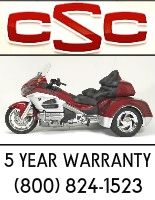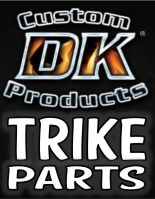Any one use these in your tri glide?
Navigation
Install the app
How to install the app on iOS
Follow along with the video below to see how to install our site as a web app on your home screen.
Note: This feature may not be available in some browsers.
More options
You are using an out of date browser. It may not display this or other websites correctly.
You should upgrade or use an alternative browser.
You should upgrade or use an alternative browser.
NGK Iridium spark plugs
- Thread starter lightnin
- Start date
DK Custom Products
Sponsor
It's been 5-6 years ago that I tried quite a few different Iridium plugs/performance plugs, including the Screamin' Eagle ones. I found that for myself, on the bikes that I tested, the factory plugs worked best.
I remember, some of the plugs seemed to provide a bit of an improvement at first, but then degraded after a few thousand miles.
Things may have changed since then.
Related to that, I did find that using quality plug wires provided a nice improvement in performance/economy.
Kevin
I remember, some of the plugs seemed to provide a bit of an improvement at first, but then degraded after a few thousand miles.
Things may have changed since then.
Related to that, I did find that using quality plug wires provided a nice improvement in performance/economy.
Kevin
Jack Klarich
Gold Member
I have to agree with Kevin here
After lots of testing different plugs I too come back to stockers
Also Kevin has good info about quality wires
Check any new wires with an ohm meter to compare how they stack up against stock ones, you might be surprised
After lots of testing different plugs I too come back to stockers
Also Kevin has good info about quality wires
Check any new wires with an ohm meter to compare how they stack up against stock ones, you might be surprised
I tried them on my 2011 Tri Glide took them out after only 2 hundred miles  felt like there was a slight hesitation on hard acceleration ?
felt like there was a slight hesitation on hard acceleration ?
 felt like there was a slight hesitation on hard acceleration ?
felt like there was a slight hesitation on hard acceleration ?I think the initial improvement would occur no matter what plug you used as the new plugs should perform better than the old worn plugs you took out. The only benefit of the iridium plugs from what I have seen, heard and read about is longevity but even that is somewhat uncertain. Personally I just stick with the stock plugs and wires. There is really nothing at all wrong with them.
DK Custom Products
Sponsor
Years ago I tested well over 100 new spark plug wires, and wrote up a report on the results.
I cannot find it anywhere. If anyone remembers it and can point me to it, I would greatly appreciate it.
Kevin
I cannot find it anywhere. If anyone remembers it and can point me to it, I would greatly appreciate it.
Kevin
Jack Klarich
Gold Member
Years ago I tested well over 100 new spark plug wires, and wrote up a report on the results.
I cannot find it anywhere. If anyone remembers it and can point me to it, I would greatly appreciate it.
Kevin
I am usually pretty good at finding things, I cannot find it either
What I do remember is that you concluded stock plugs almost always deliver the best performance. You also tested your in stock Screaming Eagle wires and found many out of spec
I agree with your findings having tested many spark plug sets only to find stock is the way to go
I may try the NGK equivalent to the Champion OEM plugs.
I believe they are CR9E.
I believe they are CR9E.
Jack Klarich
Gold Member
I may try the NGK equivalent to the Champion OEM plugs.
I believe they are CR9E.
Iridium # is CR9EIX
I ran NGK in my Streetbob and my 103 Freewheeler
I think they are a very good plug
- Moderator
- #10
ive got 60k on mine and they are running just as good as to when they were installed SE 110 motor
Iridium # is CR9EIX
I ran NGK in my Streetbob and my 103 Freewheeler
I think they are a very good plug
I was going to try the standard copper plug. This fall/winter I have a lot of maintenance planned.
I may try the NGK equivalent to the Champion OEM plugs.
I believe they are CR9E.
Just an update:
NGK CR9E is not the correct plug for the new M8 motor
I went with the OEM HD plugs & they are fine.
prariepilot
150+ Posts
Spark Plug Concerns
I have been running NGK Iridium Plugs in my '13 TG for the last 10K miles with satisfactory results. Performance meets my needs and fuel mileage is running between 36 - 40 mpg. I've attached pictures showing the electrode and ground. They appear to be tan and "fuzzy", indicating they're performing well. What concerns me is the corroded shell. Besides not looking good, is there any other reason to be concerned? I've a new set ready to put in, along with the new wires from DK.
Additionally the H-D service manual says to use a thin coating of anti-seize on the plugs when installing them. NGK says, as do other plug manufacturers, NOT to use anti-seize as it can act as a lubricant altering torque values up to 20% increasing the risk of spark plug breakage and driving the plug too deep in the head. Agree? Disagree
?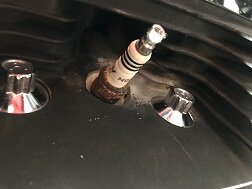
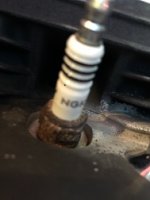
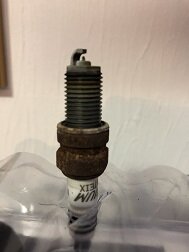


I have been running NGK Iridium Plugs in my '13 TG for the last 10K miles with satisfactory results. Performance meets my needs and fuel mileage is running between 36 - 40 mpg. I've attached pictures showing the electrode and ground. They appear to be tan and "fuzzy", indicating they're performing well. What concerns me is the corroded shell. Besides not looking good, is there any other reason to be concerned? I've a new set ready to put in, along with the new wires from DK.
Additionally the H-D service manual says to use a thin coating of anti-seize on the plugs when installing them. NGK says, as do other plug manufacturers, NOT to use anti-seize as it can act as a lubricant altering torque values up to 20% increasing the risk of spark plug breakage and driving the plug too deep in the head. Agree? Disagree
?





I have been running NGK Iridium Plugs in my '13 TG for the last 10K miles with satisfactory results. Performance meets my needs and fuel mileage is running between 36 - 40 mpg. I've attached pictures showing the electrode and ground. They appear to be tan and "fuzzy", indicating they're performing well. What concerns me is the corroded shell. Besides not looking good, is there any other reason to be concerned? I've a new set ready to put in, along with the new wires from DK.
Additionally the H-D service manual says to use a thin coating of anti-seize on the plugs when installing them. NGK says, as do other plug manufacturers, NOT to use anti-seize as it can act as a lubricant altering torque values up to 20% increasing the risk of spark plug breakage and driving the plug too deep in the head. Agree? Disagree
?View attachment 76015View attachment 76016View attachment 76017View attachment 76018View attachment 76019
They.....The rust does look bad, But remember water does collect around the plugs...
Also i do not use Anti -Seize at all....Especially with spark plugs.....I use Heat sink compound on the treads of my plugs....And that's it...
prariepilot, I'm glad the NGK's are working well for you. I know from experience that DK Customs plug wires
improvedmy performance noticablly.
I went with the OEM plugs for my M8. I did not use a thread compound, but I put 1 drop of my spray silicone on my finger and coat the plug threads, then torque to 100 inch pounds.
I also apply dielectric grease to the inside of each new plug wire at both ends, prior to installing them.
After 2 years, my stock plugs looked great & I did not have the external corrosion you had, but my trike doesn't get wet/washed much with water. While I had the tank off to install my new wires, I replaced the 4 plugs.
improvedmy performance noticablly.
I went with the OEM plugs for my M8. I did not use a thread compound, but I put 1 drop of my spray silicone on my finger and coat the plug threads, then torque to 100 inch pounds.
I also apply dielectric grease to the inside of each new plug wire at both ends, prior to installing them.
After 2 years, my stock plugs looked great & I did not have the external corrosion you had, but my trike doesn't get wet/washed much with water. While I had the tank off to install my new wires, I replaced the 4 plugs.
prariepilot
150+ Posts
prariepilot, I'm glad the NGK's are working well for you. I know from experience that DK Customs plug
Improves my performance noticablly.
I went with the OEM plugs for my M8. I did not use a thread compound, but I put 1 drop of my spray silicone on my finger and coat the plug threads, then torque to 100 inch pounds.
I also apply dielectric grease to the inside of each new plug wire at both ends, prior to installing them.
After 2 years, my stock plugs looked great & I did not have the external corrosion you had, but my trike doesn't get wet/washed much with water. While I had the tank off to install my new wires, I replaced the 4 plugs.
Thanks for the suggestion on Dielectric Grease on the wire ends. My bike has only seen a wash rack four times since new ('13); I use waterless car wash and S100 Special Surface Cleaner to "wash it". I do ride in the rain quite a bit, most times unintentionally!
I'll find out tomorrow when we go out for the 9/11 Memorial Ride how much the performance/fuel mileage has changed. Getting everything ready today, so no time to ride.
Heads up on the NGK Iridium Plugs! Took them out of the box and checked the gap. Set at .030, not the .038 - .043 the manual calls for.
Jack Klarich
Gold Member
Thanks for the suggestion on Dielectric Grease on the wire ends. My bike has only seen a wash rack four times since new ('13); I use waterless car wash and S100 Special Surface Cleaner to "wash it". I do ride in the rain quite a bit, most times unintentionally!
I'll find out tomorrow when we go out for the 9/11 Memorial Ride how much the performance/fuel mileage has changed. Getting everything ready today, so no time to ride.
Heads up on the NGK Iridium Plugs! Took them out of the box and checked the gap. Set at .030, not the .038 - .043 the manual calls for.
Check Walmart by the automotive lighting section for dilectric grease

jackthemachinist
80+ Posts
I have a DFT trike built out of a 1997 Electraglide Classic, with an S&S 111 touring motor. It has been a starter since I installed the motor. Runs great, plenty of power, but hard to start. I could never get the right amount of choke and carburetor "squirt" figured out, hot or cold, just grind, grind, grind. Installing new factory-recommended plugs would help for a short time, but within in 1000-2000 miles back to the same. The plugs never showed any excess deposits, rich, lean, anything, although a slight amount of electrode wear, nothing abnormal.
I've never had any luck with "magic" sparkplugs, but many new cars now come from the factory with iridium plugs, presumably to make those 50-100,000 mile recommended service intervals. So I decided to try a pair.
I put a set of Autolite iridium plugs in the trike, and it started right up. VAROOM! I could hardly believe it. It never started like that before. They've only been in for a few thousand miles, but it is far easier to start than it ever was before. Push the button and it fires right up, every time, just like it ought to.
I don't know about magic, but these plugs sure work in this application.
They workded so well, I put a set in my mildly hopped up 2001 Softail. I wasn't having any problems with it, but it was time for a new set of plugs so I put in iridiums. Starts the same, runs the same. Maybe they'll last longer, who knows.
I doubt there's all that much difference between brands of plugs. I use Autolites because I have had very good luck with them in racing may years ago, and have never had a problem.
The the iridiums sure solved the problems with my S&S-powered trike.
That's my experience. I never thought a different type of plug would make any difference at all, but it sure did in this case.
I've never had any luck with "magic" sparkplugs, but many new cars now come from the factory with iridium plugs, presumably to make those 50-100,000 mile recommended service intervals. So I decided to try a pair.
I put a set of Autolite iridium plugs in the trike, and it started right up. VAROOM! I could hardly believe it. It never started like that before. They've only been in for a few thousand miles, but it is far easier to start than it ever was before. Push the button and it fires right up, every time, just like it ought to.
I don't know about magic, but these plugs sure work in this application.
They workded so well, I put a set in my mildly hopped up 2001 Softail. I wasn't having any problems with it, but it was time for a new set of plugs so I put in iridiums. Starts the same, runs the same. Maybe they'll last longer, who knows.
I doubt there's all that much difference between brands of plugs. I use Autolites because I have had very good luck with them in racing may years ago, and have never had a problem.
The the iridiums sure solved the problems with my S&S-powered trike.
That's my experience. I never thought a different type of plug would make any difference at all, but it sure did in this case.
I have a DFT trike built out of a 1997 Electraglide Classic, with an S&S 111 touring motor. It has been a starter since I installed the motor. Runs great, plenty of power, but hard to start. I could never get the right amount of choke and carburetor "squirt" figured out, hot or cold, just grind, grind, grind. Installing new factory-recommended plugs would help for a short time, but within in 1000-2000 miles back to the same. The plugs never showed any excess deposits, rich, lean, anything, although a slight amount of electrode wear, nothing abnormal.
I've never had any luck with "magic" sparkplugs, but many new cars now come from the factory with iridium plugs, presumably to make those 50-100,000 mile recommended service intervals. So I decided to try a pair.
I put a set of Autolite iridium plugs in the trike, and it started right up. VAROOM! I could hardly believe it. It never started like that before. They've only been in for a few thousand miles, but it is far easier to start than it ever was before. Push the button and it fires right up, every time, just like it ought to.
I don't know about magic, but these plugs sure work in this application.
They workded so well, I put a set in my mildly hopped up 2001 Softail. I wasn't having any problems with it, but it was time for a new set of plugs so I put in iridiums. Starts the same, runs the same. Maybe they'll last longer, who knows.
I doubt there's all that much difference between brands of plugs. I use Autolites because I have had very good luck with them in racing may years ago, and have never had a problem.
The the iridiums sure solved the problems with my S&S-powered trike.
That's my experience. I never thought a different type of plug would make any difference at all, but it sure did in this case.
Try the plug wires that DK Customs sells. You will be amazed.
prariepilot, Thanks for the tip on checking the plug gap. It's a little different gap space for the M8, but the HD dealer told me they were gapped already, but I always set mine to the lower end of the gap range, in case they open up a little.
Trust, but verify.
Have a great Memorial ride tomorrow!
Trust, but verify.
Have a great Memorial ride tomorrow!
Jack Klarich
Gold Member
Check out #2 on this list Many confuse this as rust
Many confuse this as rust
5 Things You Should Know About Spark Plugs
1. Anti-seize
NGK spark plugs feature what is known as trivalent plating. This silver- or chrome-colored finish on the threads is designed to provide corrosion resistance against moisture and chemicals. The coating also acts as a release agent during spark plug removal. NGK spark plugs are installed at the factory dry, without the use of anti-seize. NGK tech support has received a number of tech calls from installers who have over-tightened spark plugs because of the use of anti-seize. Anti-seize compound can act as a lubricant altering torque values up to 20 percent, increasing the risk of spark plug thread breakage.
2. Corona stain
Corona stain is observed as a light brown or tan discoloration above the hex (located on the ceramic body of the spark plug). Corona stain is created by oil or dirt particles surrounding the spark plug. Spark plugs create a high amount of static electricity as they fire, attracting these particles to the exposed ceramic between the plug boot and the hex. Corona stain is completely normal and should not be mistaken for exhaust gas blow-by or broken seals inside the spark plug.
3. Gapping fine-wire spark plugs
In the late 1980s, when fine-wire spark plugs first appeared, installers used incorrect gap tools and procedures resulting in bent or broken-off firing electrodes. As a result, many people assumed that one cannot adjust the gap on a precious metal plug. While most NGK spark plugs are pre-gapped, there are instances where the gap requires modification. NGK recommends a wire-style or feeler gage gap tool, which can adjust the gap without prying against the center electrode. NGK also recommends adjusting the gap no more than +/- 0.008” from the preset gap.
4. Torque
Torque is critical in the plug’s ability to dissipate heat and perform properly. Always follow the manufacturer’s recommended torque specification. An under-torqued spark plug can lead to excessive vibration and improper heat dissipation, causing spark plug and/or engine damage. An over-torqued spark plug may cause thread damage or breakage, or compromise internal seals within the spark plug, leading to improper heat dissipation or exhaust gas blow-by.
5.“Copper spark plugs”
“Copper spark plugs” is a term mistakenly used for a standard material spark plug. A standard material spark plug traditionally uses a nickel-alloy outer material fused to a copper core. Almost all spark plugs use a copper core center to conduct the electricity, jump the gap, and promote heat dissipation. However, as an outer electrode material, copper would not be a good choice, as it is soft and has a low melting point (resulting in a plug that would last minutes, not miles). Nearly all NGK spark plugs, including precious metals iridium and platinum, have a copper core. When one talks in terms of nickel alloys, platinum and iridium, one is referring to its durability, or how long a spark plug will last before it needs to be replaced. However, when one talks about copper, he or she is referring to its ability to conduct electricity that is needed to fire across the gap and ignite the air-fuel mixture.
5 Things You Should Know About Spark Plugs
1. Anti-seize
NGK spark plugs feature what is known as trivalent plating. This silver- or chrome-colored finish on the threads is designed to provide corrosion resistance against moisture and chemicals. The coating also acts as a release agent during spark plug removal. NGK spark plugs are installed at the factory dry, without the use of anti-seize. NGK tech support has received a number of tech calls from installers who have over-tightened spark plugs because of the use of anti-seize. Anti-seize compound can act as a lubricant altering torque values up to 20 percent, increasing the risk of spark plug thread breakage.
2. Corona stain
Corona stain is observed as a light brown or tan discoloration above the hex (located on the ceramic body of the spark plug). Corona stain is created by oil or dirt particles surrounding the spark plug. Spark plugs create a high amount of static electricity as they fire, attracting these particles to the exposed ceramic between the plug boot and the hex. Corona stain is completely normal and should not be mistaken for exhaust gas blow-by or broken seals inside the spark plug.
3. Gapping fine-wire spark plugs
In the late 1980s, when fine-wire spark plugs first appeared, installers used incorrect gap tools and procedures resulting in bent or broken-off firing electrodes. As a result, many people assumed that one cannot adjust the gap on a precious metal plug. While most NGK spark plugs are pre-gapped, there are instances where the gap requires modification. NGK recommends a wire-style or feeler gage gap tool, which can adjust the gap without prying against the center electrode. NGK also recommends adjusting the gap no more than +/- 0.008” from the preset gap.
4. Torque
Torque is critical in the plug’s ability to dissipate heat and perform properly. Always follow the manufacturer’s recommended torque specification. An under-torqued spark plug can lead to excessive vibration and improper heat dissipation, causing spark plug and/or engine damage. An over-torqued spark plug may cause thread damage or breakage, or compromise internal seals within the spark plug, leading to improper heat dissipation or exhaust gas blow-by.
5.“Copper spark plugs”
“Copper spark plugs” is a term mistakenly used for a standard material spark plug. A standard material spark plug traditionally uses a nickel-alloy outer material fused to a copper core. Almost all spark plugs use a copper core center to conduct the electricity, jump the gap, and promote heat dissipation. However, as an outer electrode material, copper would not be a good choice, as it is soft and has a low melting point (resulting in a plug that would last minutes, not miles). Nearly all NGK spark plugs, including precious metals iridium and platinum, have a copper core. When one talks in terms of nickel alloys, platinum and iridium, one is referring to its durability, or how long a spark plug will last before it needs to be replaced. However, when one talks about copper, he or she is referring to its ability to conduct electricity that is needed to fire across the gap and ignite the air-fuel mixture.
prariepilot
150+ Posts
Check out #2 on this listMany confuse this as rust
5 Things You Should Know About Spark Plugs
1. Anti-seize
NGK spark plugs feature what is known as trivalent plating. This silver- or chrome-colored finish on the threads is designed to provide corrosion resistance against moisture and chemicals. The coating also acts as a release agent during spark plug removal. NGK spark plugs are installed at the factory dry, without the use of anti-seize. NGK tech support has received a number of tech calls from installers who have over-tightened spark plugs because of the use of anti-seize. Anti-seize compound can act as a lubricant altering torque values up to 20 percent, increasing the risk of spark plug thread breakage.
2. Corona stain
Corona stain is observed as a light brown or tan discoloration above the hex (located on the ceramic body of the spark plug). Corona stain is created by oil or dirt particles surrounding the spark plug. Spark plugs create a high amount of static electricity as they fire, attracting these particles to the exposed ceramic between the plug boot and the hex. Corona stain is completely normal and should not be mistaken for exhaust gas blow-by or broken seals inside the spark plug.
3. Gapping fine-wire spark plugs
In the late 1980s, when fine-wire spark plugs first appeared, installers used incorrect gap tools and procedures resulting in bent or broken-off firing electrodes. As a result, many people assumed that one cannot adjust the gap on a precious metal plug. While most NGK spark plugs are pre-gapped, there are instances where the gap requires modification. NGK recommends a wire-style or feeler gage gap tool, which can adjust the gap without prying against the center electrode. NGK also recommends adjusting the gap no more than +/- 0.008” from the preset gap.
4. Torque
Torque is critical in the plug’s ability to dissipate heat and perform properly. Always follow the manufacturer’s recommended torque specification. An under-torqued spark plug can lead to excessive vibration and improper heat dissipation, causing spark plug and/or engine damage. An over-torqued spark plug may cause thread damage or breakage, or compromise internal seals within the spark plug, leading to improper heat dissipation or exhaust gas blow-by.
5.“Copper spark plugs”
“Copper spark plugs” is a term mistakenly used for a standard material spark plug. A standard material spark plug traditionally uses a nickel-alloy outer material fused to a copper core. Almost all spark plugs use a copper core center to conduct the electricity, jump the gap, and promote heat dissipation. However, as an outer electrode material, copper would not be a good choice, as it is soft and has a low melting point (resulting in a plug that would last minutes, not miles). Nearly all NGK spark plugs, including precious metals iridium and platinum, have a copper core. When one talks in terms of nickel alloys, platinum and iridium, one is referring to its durability, or how long a spark plug will last before it needs to be replaced. However, when one talks about copper, he or she is referring to its ability to conduct electricity that is needed to fire across the gap and ignite the air-fuel mixture.
Jack, It is definitely corrosion and not the "Corona" mentioned in #2. Even the Hex area is corroded. I ride in thunderstorms, rainshowers, and salt air six months out of the year on the east central coast of FL. I put this set in about a year and a half ago, so the elements have taken their toll.
I'm much more familiar with the workings of automotive applications. Ran and wrenched a B/Gas rail and a '47 Anglia Fuel/Altered in PDRA in the late '60's. I've only started working on my motorcycles since 2001.
Jack Klarich
Gold Member
Jack, It is definitely corrosion and not the "Corona" mentioned in #2. Even the Hex area is corroded. I ride in thunderstorms, rainshowers, and salt air six months out of the year on the east central coast of FL. I put this set in about a year and a half ago, so the elements have taken their toll.
I'm much more familiar with the workings of automotive applications. Ran and wrenched a B/Gas rail and a '47 Anglia Fuel/Altered in PDRA in the late '60's. I've only started working on my motorcycles since 2001.
Yeah, I see the rust in your pictures now
My 97 FLHT did that after 1 year here in Florida
Good on you for doing your own wrenching
I am a retired wrench, have turned wrenches all my life


